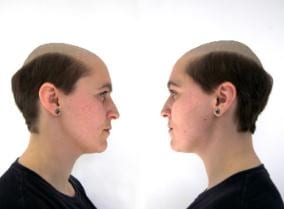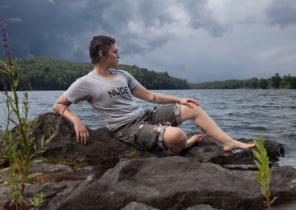
Back and Forth. Credit: Cara Tierney
Cara Tierney’s Ottawa adventure began 10 years ago when she moved to the capital from Quebec to pursue the arts. She’s just finished a second master’s degree and has prepared a daring new exhibit.
Based on the theme of negotiating and constructing social identity, Go Forth and Multiply was two years in the making. Using photography as a medium, Tierney uses self-portraits to express her frustration at society’s lack of education for the queer community.
Xtra chatted with Tierney about Go Forth and Multiply.
Xtra: What were the underlying emotions that led to the creation of this group of portraits?
Cara Tierney: This exhibit was propelled forward by frustration. Frustration towards society in general. I’m frustrated with what I’ve been taught is a man and a woman, and how the two are supposed to work. Men and women are not equivalent to male and female; there are so many more levels than that. The fact that we have two categories for gender is completely insufficient. And I think that is something that society at large does not understand, and there’s a lack of queer education at all levels of society and a lack of role models. Both result in feeling misunderstood.
Why the importance of role models?
I grew up in an incredibly straight environment, with no queer role models. When I did meet queer people it was mind-blowing! I didn’t come out until I was 26, which is late by today’s standards . . . and to switch gears that late in life, there’s that feeling of inauthenticity, and it takes a while to work through. If you don’t have those role models in your environment, it takes you longer to get to where you need to be.
How does this show connect with the queer community, and what kind of response are you expecting?
The content is queer and about being queer and is structured in such a way that the viewer is encouraged to bring their own interpretation to the works. Being queer means different things for different people and, in this regard, the show avoids being prescriptive but rather hopes to foster open dialogue. The production of this particular work is a response to the lack of visible queer subjects in our environments. As everyone is different and brings different baggage with them when they visit an art gallery, I expect the responses to be as varied as the viewers.
Why do you think art is important in terms of self-expression and personal growth?
Because verbal language doesn’t encompass every expression. Some things need to be expressed with colour, shapes, sounds, smells, experiences.
Why do you believe it is important to be an individual and think “outside the box” and not follow the crowd?
I have found the “box” to be exceptionally painful and damaging in my lifetime. It is small and cramped in there! I don’t see thinking outside the box as an ability, per se. Being queer, my survival depends on it. It’s more like thinking away from the box, or even thinking away the box. Normal kills.
How does this project differ from others you’ve done in the past?
The upcoming exhibit shows a new side to my practice and brings my work into a new context, providing me with a great springboard from which to launch this next phase of my career. Before this I was involved in performance art, which has something really edgy about it, very effective, yet fleeting. With both, though, people are observing you. Any form of art boils down to authenticity. When you live in the closet there’s a sense of falseness, so as an artist you need to be genuine.
How do you deal with the criticism?
No one has said anything overly negative as of yet, but most times if people say something, that opinion is coming from somewhere and there’s meaning to it. My strategy is to always express things I know, things about myself. That way, if somebody tells me I’m wrong, I can say I can’t be wrong because it’s about me, not them.
The Deets:
Go Forth and Multiply
Opens Mon, Aug 27, 5pm
Carlton University Art Gallery
St Patrick’s Building 1125 Colonel By Dr
Artist’s talk
Sat, Sept 29, 2pm
cuag.carleton.ca

 Why you can trust Xtra
Why you can trust Xtra


